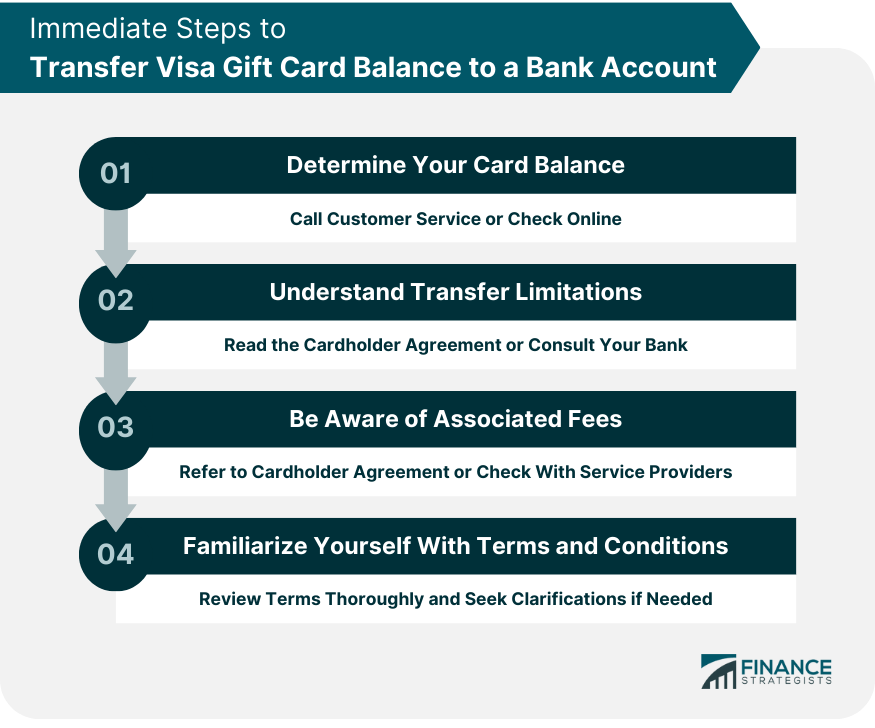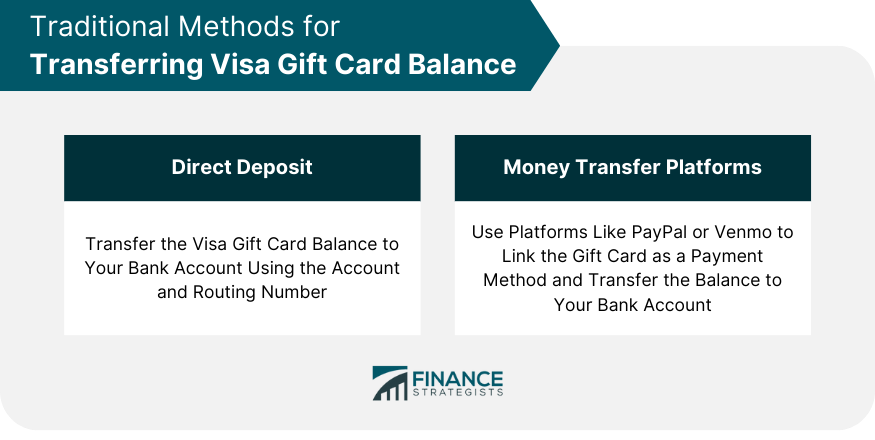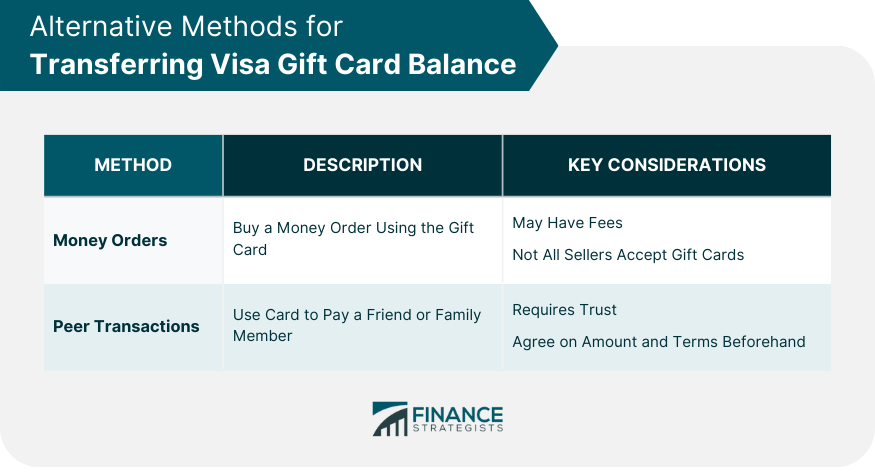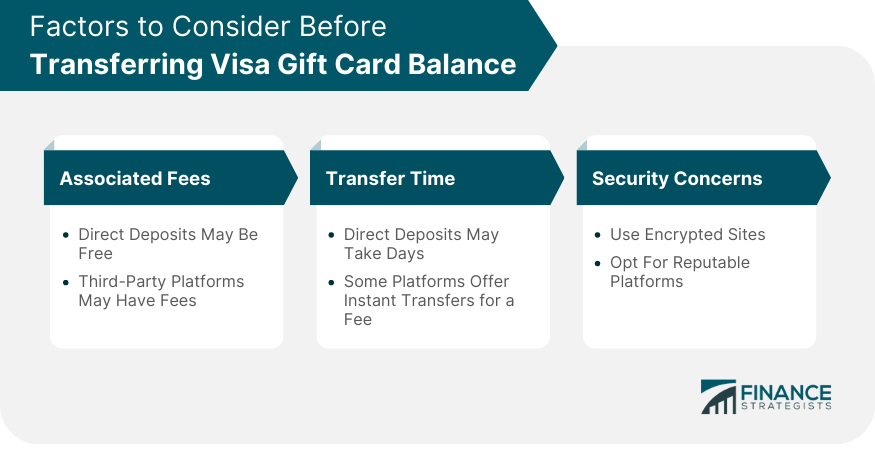A Visa Gift Card is a prepaid card that can be used for purchasing goods and services anywhere Visa debit cards are accepted, such as physical stores, online shopping sites, or over the phone. They come pre-loaded with a set amount of money that you choose at the time of purchase. The recipient can use the card until the balance is depleted. The card doesn't require a bank account or credit check and it doesn't link to any personal information, providing an extra layer of privacy. Moreover, it makes for a convenient and flexible gift option for a variety of occasions since the recipient has the freedom to choose their own gift. Unlike cash, if the card is lost or stolen and you have the card number, most issuers will help recover your money. However, these cards usually cannot be reloaded, and they may have expiration dates or maintenance fees. It's crucial to know how much money is on your gift card before initiating any transfer. This will help you ascertain if any fees have been deducted and ensure you transfer the correct amount. Call Customer Service: Flip your gift card to its back. Locate the customer service phone number and give them a call. They will guide you through the process, and after providing some card details, they will tell you the remaining balance. Online Check: If your gift card issuer provides online services, visit the corresponding website. Typically, there will be a section to "Check Balance" or something similar. Enter your card number, expiration date, and any other required details to view your balance. Not all Visa gift cards can be used universally for every type of transaction. There might be restrictions, especially when trying to transfer the balance to a bank account. Understanding these limitations ensures you don't hit a roadblock later on. Read the Cardholder Agreement: This is usually a pamphlet or booklet that came with your gift card or can be found online. This document details the do's and don'ts with your card. Check With your Bank: Sometimes, it's not the gift card that's the issue but the bank. They might have restrictions or specific methods for such transfers. A quick call or visit to your bank can clarify this. Transferring money often comes with fees, especially when an intermediary is involved. It's essential to know any costs upfront, so you aren't caught off guard. Refer to the Cardholder Agreement: Again, this document is invaluable. It should detail any fees associated with different kinds of transactions. Check With Service Providers: If you're using a third-party service (like PayPal or another money transfer platform), always check their fee structure. They will typically have this information detailed on their website or through their customer support. Beyond fees and limitations, the terms and conditions give you a broader understanding of what you're getting into. They will provide information on dispute resolutions, loss of card, and other pertinent topics. Detailed Review: Dedicate time to read the terms and conditions thoroughly. It's tedious but necessary to avoid any unpleasant surprises. Seek Clarifications: If there's any point you don't understand, either contact the card issuer's customer service or consult with someone knowledgeable. Once you have confirmed the balance and understood the terms, you can choose the method of transfer. There are traditional methods that are widely accepted and have been proven to work. Many people are familiar with direct deposit through their employment, where their paycheck is automatically deposited into their bank account. This method can also be used to transfer the balance from a Visa gift card to your bank account. To set up direct deposit, you will need to provide the account and routing number associated with your gift card. You can usually find this information on the website or app associated with the card. Once you have these numbers, you can set up a direct deposit with your bank, just like you would for a paycheck. However, not all gift cards provide an account and routing number, and not all banks accept direct deposits from gift cards. Always check with your bank and read the terms and conditions of your gift card to ensure this method is possible. If direct deposit isn't an option, or if you'd prefer a different method, you can use a money transfer platform such as PayPal or Venmo. These platforms allow you to link your Visa gift card as a payment method, after which you can transfer the balance to your bank account. To use this method, create an account with the money transfer platform (if you don't have one already) and go to the payment methods or wallet section. There, you should see an option to add a card. Input your Visa gift card details, and once the card is linked, you can transfer the balance to your bank account. Keep in mind that these platforms may charge a fee for the transfer, and the transfer might not be instantaneous. Always check the terms and conditions of the platform to understand any potential fees and timelines. A money order is a payment order for a specific amount of money. It's a more trusted method of payment than a personal check, as it is prepaid. You can use your Visa gift card to purchase a money order at a post office, grocery store, or check-cashing store. Once you have the money order, you can cash it or deposit it at your bank just like a check. However, keep in mind that there may be fees associated with purchasing a money order, and not all places that sell money orders accept gift cards as a form of payment. Always check the terms and conditions before choosing this method. If you have a trusted friend or family member who is willing to help, you could use your gift card to pay them for a service or item, and they could then give you the money in cash or transfer it to your bank account. This method requires trust and transparency to ensure a fair transaction. It's important to agree on the amount and the terms of the transaction beforehand to avoid any misunderstandings. Different transfer methods come with distinct cost structures. It's vital to be aware of these fees to avoid unexpected expenses and to ensure you maximize the amount you receive. Direct Deposit: This method often comes without any fees, making it a cost-effective way to transfer your balance. Money Transfer Platforms: Platforms such as PayPal or Venmo might charge fees, either for the transaction itself or for expedited transfer services. Money Orders: Acquiring a money order using your gift card might come with a nominal fee, which varies depending on where you purchase it. The duration it takes for the funds to move from your gift card to your bank account can vary significantly. Depending on your urgency, this can influence your method choice. Direct Deposit: This method is generally reliable, but it may take a few days for the funds to reflect in your bank account. Money Transfer Platforms: Some platforms offer almost immediate transfers, but these might come at an additional cost. Others might take a day or two. In the digital age, the security of your financial and personal information is paramount. Always ensure that your chosen method is safe and that your details are protected. Secure Connection: When using online platforms, always look for the padlock symbol in your browser's address bar. This indicates that your connection is encrypted and secure. Reputation of the Platform: Opt for platforms with a strong reputation and positive user reviews. Trusted platforms prioritize user security and take measures to protect data. Be Cautious: Avoid sharing your gift card details on shady websites or with unverified third parties. Always double-check URLs and ensure you're on the official site. Transferring a Visa gift card balance to a bank account is a nuanced process requiring an understanding of card balance, transfer limitations, associated fees, and the terms and conditions. With careful preparation and evaluation, one can employ traditional methods like direct deposit and money transfer platforms, or alternative methods such as money orders or peer transactions, each with their pros and cons. Fees, transfer times, and security concerns are essential factors to consider when choosing a transfer method. Ultimately, the process allows flexibility in gift card utilization, turning them into a more accessible fund source, extending their usability beyond standard retail transactions. For professional advice on managing these kinds of transactions more effectively, consider seeking banking services tailored to your needs.Understanding Visa Gift Cards
Immediate Steps to Transfer Visa Gift Card Balance to a Bank Account
Step 1: Determine Your Card Balance
Step 2: Understand the Transfer Limitations
Step 3: Be Aware of Associated Fees
Step 4: Familiarize Yourself With Terms and Conditions

Traditional Methods for Transferring Visa Gift Card Balance
Direct Deposit
Money Transfer Platforms

Alternative Methods for Transferring Visa Gift Card Balance
Money Orders
Peer Transactions

Factors to Consider Before Transferring Gift Card Balance
Associated Fees
Transfer Time
Security Concerns

Bottom Line
How to Transfer Visa Gift Card Balance to a Bank Account FAQs
You can check your balance by calling the card's customer service or using the issuer's online services.
Yes, depending on the method used, there may be fees. Check the cardholder agreement or third-party service terms for details.
Some gift cards and banks allow direct deposit using the card's account and routing number. Always confirm with your bank first.
Platforms like PayPal and Venmo can be used, but be aware of potential fees and transfer timelines.
Always use encrypted websites, choose reputable platforms, and remain cautious of potential scams.
True Tamplin is a published author, public speaker, CEO of UpDigital, and founder of Finance Strategists.
True is a Certified Educator in Personal Finance (CEPF®), author of The Handy Financial Ratios Guide, a member of the Society for Advancing Business Editing and Writing, contributes to his financial education site, Finance Strategists, and has spoken to various financial communities such as the CFA Institute, as well as university students like his Alma mater, Biola University, where he received a bachelor of science in business and data analytics.
To learn more about True, visit his personal website or view his author profiles on Amazon, Nasdaq and Forbes.















